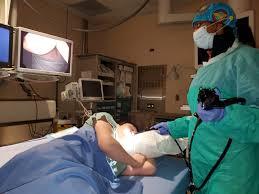
Endoscopy services are crucial for diagnosing and treating various medical conditions by allowing direct visualization of the internal organs and structures. Here’s an overview of what endoscopy services typically involve:
1. Endoscopy
- Endoscopy is a procedure that uses a flexible tube with a camera (endoscope) to visualize the inside of the body. It can be used for diagnostic purposes and therapeutic interventions.
- Commonly used to examine the gastrointestinal tract, respiratory tract, urinary tract, and other internal areas.
2. Types of Endoscopy
- Upper Endoscopy (EGD): Examines the esophagus, stomach, and upper part of the small intestine.
- Colonoscopy: Visualizes the colon and rectum to screen for colorectal cancer and other conditions.
- Bronchoscopy: Allows examination of the airways and lungs.
- Cystoscopy: Views the bladder and urethra.
- Laparoscopy: A minimally invasive surgical procedure used to examine the abdominal cavity.
3. Endoscopy Procedure
-
Preparation:
- Dietary Restrictions: Patients may need to follow specific dietary guidelines before the procedure (e.g., fasting or avoiding certain foods).
- Medication Review: Discuss medications with the healthcare provider, especially blood thinners.
-
During the Procedure:
- Patients are usually sedated for comfort, although some procedures can be done under local anesthesia.
- The endoscope is gently inserted through a natural opening (mouth, anus, etc.) or through small incisions (in the case of laparoscopy).
- The camera transmits images to a monitor, allowing the physician to assess the area.
-
Duration: The procedure can take anywhere from 15 minutes to an hour, depending on the type of endoscopy and what is being examined.
4. Safety and Risks
- Minimally Invasive: Endoscopy is generally safe, with a low risk of complications.
- Potential Risks: Include bleeding, infection, and perforation of the organ being examined, though these are rare.
- Recovery: Most patients can go home the same day, but some may require a brief recovery period due to sedation.
5. Interpreting Results
- Biopsy: If necessary, tissue samples can be taken during the procedure for further analysis.
- Follow-Up: Results are discussed with the patient, and a treatment plan may be developed based on findings.
6. Advancements in Endoscopy Technology
- High-Definition Imaging: Modern endoscopes provide clearer images and better visualization.
- Capsule Endoscopy: A small, swallowable camera that captures images of the gastrointestinal tract as it moves through the body.
7. Accessibility
- Hospital Services: Our hospitals have specialized endoscopy units or departments.
- Outpatient Centers: Many outpatient facilities also provide endoscopy services, often focusing on routine screenings and diagnostics.